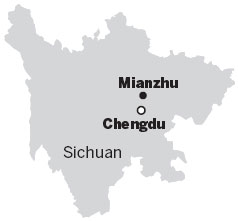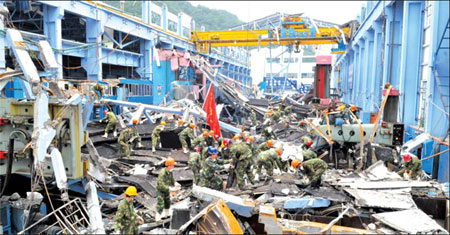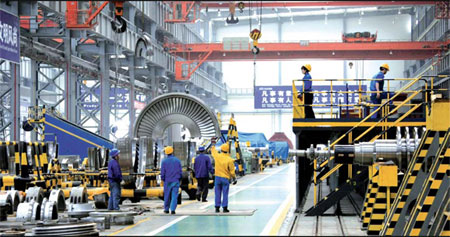Turbine maker turns around
Updated: 2013-05-10 08:52
(China Daily)
|
|||||||||||
|
The earthquake reduced the plants of Dongfang Turbine Co in Hanwang town, Deyang city, to debris. Li Jing / The PLA Daily |
|
The new plant of Dongfang Turbine Co in Bajiao town, Deyang city, features advanced equipment and provides better lives for its employees. Huang Yiming / China Daily |
The post-quake relocation of Dongfang Turbine Co's base brings improvements and pressures for workers.
Mianzhu
Editor's note: Mianzhu is less than 50 km from the Wenchuan quake's epicenter and was among the most devastated areas. This page looks at the reconstruction of the city.

Much has changed for technician Li Zhongyu and his co-workers since May 12, 2008, when he saw part of the factory explode in the Wenchuan earthquake and went searching among ruins for his girlfriend in Hanwang town. The 29-year-old Hubei native married her last year. She now lives at their new home in Bajiao township, Sichuan province, caring for their newborn son. Dongfang Turbine Co Ltd relocated to Bajiao, from Hanwang, a company town built around the plant. Workers say the relocation of their destroyed factory and rebuilding of the quake zone has changed their lives. Hanwang lost about 17,000 of its 43,000 residents, mostly migrant workers, as a result of the quake. Many died and others left town because there was no work without the plant.
About 1,400 workers moved to Bajiao.
The "new base", as workers call it, covers 173 hectares in Kaifang district's new science and technology economic zone. It hosts about 60 percent of the enterprise's workers.

It's half as large but twice as efficient as the old base, workers say. And the city is larger, which brings new opportunities - and pressures.
But it's a step up for Li and his wife.
"She likes it better here than in Hanwang," Li says."It's bigger."
Yet Bajiao's advantages blend with drawbacks.
"The air is worse because there are so many factories. And the transportation is less convenient," Li says.
It used to take him a few minutes to get to work, and it now takes 40.
"The location isn't as good, but the equipment is better," Li says.
His colleague Deng Hui agrees.
"We used to work on a hill in a so-so factory. The new plant is very advanced," says the 33-year-old from Sichuan's Shehong county. "We've got new houses and cars. Everything is better here."
Deng came after the old factory was abandoned in 2011. "We just want a place to work, to show our worth and help build society," he says.
He rides his bike to work, since the quake gave him a greater appreciation of health and the environment, he says.
Crane operator Wen Rui says salaries are also better at the new plant.
"But the requirements are also stricter," says the 38-year-old Chengdu native, who has worked at Dongfang since 1994.

She earned 1,200 yuan ($194) a month in Hanwang and gets more than 3,000 yuan in Bajiao.
"Outside work, the big city brings many conveniences but also demands," she says.
Deng says her 15-year-old daughter's education has been her greatest concern. But her informal learning experiences are broader, she explains.
"Here, we can own a car and take our daughter around on weekends," Wen says.
"The city offers more to stimulate her development. She can go more places, meet more people, see more things. It expands her horizons."
Yet the downside of the better location is traffic.
Still, the workers agree the relocation is worth the hassles.
"Aside from the deaths, the earthquake was a great thing for people here," Wen says.
"The recovery has pushed our lives beyond where they would have been by this point. Life is getting better."
(China Daily 05/10/2013 page26)
Today's Top News
List of approved GM food clarified
ID checks for express deliveries in Guangdong
Govt to expand elderly care
University asks freshmen to sign suicide disclaimer
Tibet gears up for new climbing season
Media asked to promote Sino-Indian ties
Shots fired at Washington Navy Yard
Minimum growth rate set at 7%
Hot Topics
Lunar probe , China growth forecasts, Emission rules get tougher, China seen through 'colored lens', International board,
Editor's Picks

|

|

|

|

|

|







